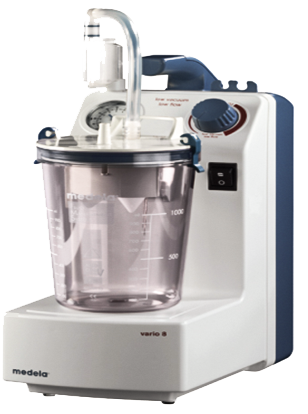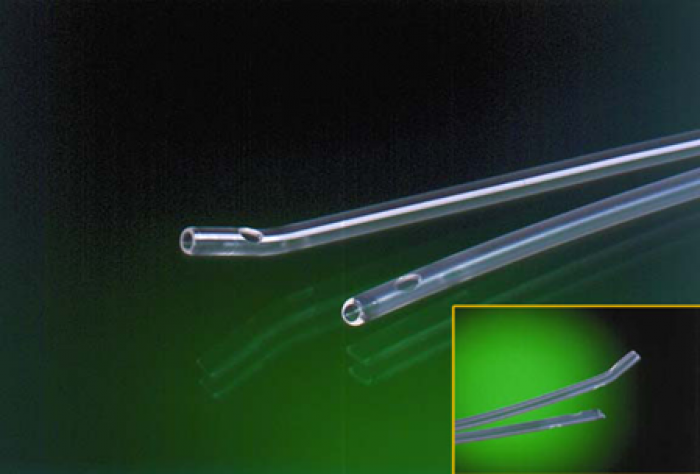Module 2: Breathing with
Suction
Suction involves a low pressure-producing device and the actual suction catheter. The cannula makes the windpipe narrower, which makes it more difficult to cough up mucus. In addition, many of those with a tracheostomy also have a disease that weakens the ability to cough.

Sug er derfor et viktig hjelpemiddel for å få opp slim fra luftveiene. Sug kan brukes i kombinasjon med andre hosteteknikker eller som slimmobiliserende teknikk alene. Sug kan også brukes til å fjerne slim fra munnen. Alle som har trakeostomi skal ha sug.
Using suction
When should suction be used?
- When ‘crackling’ can be heard or the vibration of secretions can be felt upon aspiration.
- When alarms (high pressure or low volume) on the ventilator sound (see the applicable chapter).
- When the user wants it.
- With acute breathing problems (see the applicable chapter).
- With mucus clearing procedures.
Problems that could arise if the wrong suction technique is used
- Patient discomfort
- Damaged mucous membranes in the airways.
- Increased production of mucus.
- Risk of infection.
- Mucus can accumulate in the cannula or airway.
During suction, the ventilator is disconnected and the user does not receive air during suction. This can be uncomfortable. Good cooperation with the user is essential. Therefore, it must be done calmly, quickly and efficiently. If suction needs to be repeated several times in a row, make sure that the ventilator is reconnected or a bag is used between each suction.
Equipment
Suction devices
- A suction catheter is a sterile disposable catheter, which must be discarded after each suction or after each performed procedure.
- Suction tube - a tube from the suction flask to the suction catheter. Must be replaced once every 24 hours or with extensive contamination.
- Suction flask - to be replaced as necessary. With multiple flasks: once every 24 hours.
- A supply of water for flushing the suction tube. Containers/bottles of tap water for flushing the suction tube upon disconnection of the suction catheter.
Suction catheters
A suction catheter is a pipe, which must be connected to a suction device to remove secretions in the mouth or tracheal cannula. There are two types of suction catheters.

- Straight
- Curved
Both types are available in different lengths. Suction catheters also vary in thickness. Suction catheters are selected based on the size of the patient’s cannula.
Suction inside a cannula
When suctioning the cannula, suction is limited to the actual cannula. This is how suctioning is most commonly used. Therefore, measure how far the suction catheter will be inserted beforehand. The suction must not go further than approx. 0.5 cm of the end of the cannula inside the windpipe. This can be done, for example, by placing a suction catheter at the side of the user and marking off the correct length.
This technique is used to remove mucus in the actual cannula. Thus, mucus here may be spontaneously coughed up or when using a cough assist machine. The removal of mucus prevents the accumulation of mucus on the inside of the walls of the cannula and gradual blockage therein. By clearing the mucus in the actual cannula and then removing it with suction, one ensures that the suction does not come into contact with tracheal mucous membrane. Regular suction prevents the cannula from becoming blocked. Therefore, it is generally recommended to use suction in the cannula in the morning and evening as a permanent measure, or as needed.
Deep suction technique
With the deep suction technique, suction is passed down via the cannula until resistance is felt, the suction is then activated and suctioning is performed on the way out. This technique clears mucus that is stuck in the lower airways at the bottom of the cannula. Sometimes this technique is used regularly instead of, or in addition, to a cough assist device. This technique is often used in emergency situations when mucus cannot be cleared by other method. If this technique is used frequently, it can increase the production of mucus or damage respiratory mucosa.
Removing mucus above the cuff
If a cannula is used with a cuff, the mucus can accumulate over the cuff inside the windpipe. The mucus can cause problems when purging the cannula of air or water, as it could move down into the lungs. The mucus can also move down into the lungs even if the cuff is used, thus presenting a risk of infection. Subsequently, a foul odour could arise and it could leak out on the side of the cannula.
Some patients do not experience any problems at all with mucus. When replacing a cannula or purging the cannula in order to talk, various techniques can be used to manage the mucus. The airflow can be used to blow the mucus up into the mouth, as the airflow will lead the mucus into the mouth as the cuff is purged. The airflow can be created by a bag or cough assist machine.
The mucus can also be removed by using a cannula as an extension of suctioning by withdrawing the mucus as the cannula is replaced. Some cannulas have a separate suction channel above the cuff; others remove the mucus above the cuff everyday, whilst others only remove it when the cannula is replaced. In general, it cannot be said that one method is better than another. The doctor in charge of the treatment will, in consultation with the user, determine the best method for him/her.